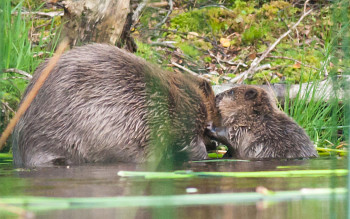
Knapdale beaver kit with adult
As part of the partnership project between the Scottish Wildlife Trust and the Royal Zoological Society of Scotland, which achieved conservation history last May by launching the first formal trial reintroduction of a mammal back to the UK, the newborn beavers (known as kits) are estimated to be eight weeks old and their sighting marks a positive achievement in the progress of this landmark project.
Christian Robstad, the Royal Zoological Society of Scotland’s Beaver Field Officer, described his experience spotting Scotland’s exciting new arrivals, “Seeing the Trial’s newborn beaver kits was really amazing – this is a huge achievement for the project and for conservation in the UK.
“It’s often difficult to tell if wild beavers are pregnant especially as they are elusive and largely nocturnal animals, but with our adult female beavers at two sites known to be in peak condition, there was a real possibility that kits could follow.
“Increasingly in the last few weeks, staff and volunteers have seen more evidence that there were young around and tracking activities were stepped up. After weeks of patient observation, we were finally rewarded with not just one kit being spotted but a second kit from a different family group as well.
“The first emerged as part of a ‘family outing’ with its parents and older sister close by to offer additional protection. It kept close to the edge of the loch and called out to its family for reassurance while it began to learn to forage for food.”
Simon Jones, the Scottish Wildlife Trust’s Scottish Beaver Trial Project Manager, continued, “Receiving confirmation of the presence of at least two beaver kits this year in Knapdale is a fantastic step forward for the Scottish Beaver Trial as we can now begin to see how a small reintroduced population starts to naturally establish itself in the wild.
“Both these beaver families are real Trial success stories, having settled into Knapdale very well. Both have built their own lodge and one family has had great success building a dam to access better food supplies. This has created a magnificent new area of wetland in which wildlife is now flourishing in.
“As beaver kits are very small, shy and look very similar to one another, there is a chance that even more kits have been born this year. We will be tracking our animals closely and hope to determine the exact number of kits produced as part of the Trial soon. This task will be made easier for us as the kits get older and more confident about emerging from the lodge and foraging for food on their own.”
Minister for Environment Roseanna Cunningham said, “It’s exciting to see these beavers thriving in the Knapdale Forest and producing beaver kits so soon after their reintroduction.
“We were hoping that this would happen and I’m looking forward to watching the progress of the beaver families over the coming years.
“This is a small but significant step for the Scottish Beaver Trial.”
Allan Bantick, Chair of the Scottish Beaver Trial Steering Group, said, “This is a red letter day for wildlife conservation in Scotland. The birth of kits is a truly significant milestone in the development of the beaver trial and confirms our belief that beavers will thrive in the Scottish environment.
“Conservationists and ecologists have campaigned for fifteen years for the return of the beaver to Scotland and thereby to correct the mistake of four hundred years ago when beavers were hunted to extinction. These births are small but significant steps in that direction.
“Over the five-year trial period, we will watch the beavers and keep detailed records of their activities. We now have good reason to be confident that our beaver families will produce young which will disperse after two years to look for mates and establish their own breeding family groups. We believe the trial area is large enough to sustain this population growth over the course of the trial period and beyond.”
Nick Purdy from Forestry Commission Scotland, the Trial’s host partner, said, “We are delighted to have the beavers resident in Knapdale and this is just the news we have been hoping for. I know visitors will be keen to get a sighting of the new arrivals, but will also understand that this is a very sensitive time for these beaver families. It would be of great help to the beavers if the public avoided the loch edge for the next few weeks to help minimise disturbance while the kits get used to their new environment.”
Currently about the size of a large guinea pig, beaver kits weigh about one pound at birth. They are born with a full coat of fur, their eyes open and the ability to swim. Older kits within the family may help care for and defend the younger ones but when they reach about two years old, they will leave the group in search of their own territory.
The Scottish Beaver Trial aims to provide information which could determine whether or not beavers are reintroduced into the wild across Scotland. Twenty-five European countries have already reintroduced beavers to their wild lands. Beavers were a native species to the UK and were once a common sight before they were hunted to extinction by man. Beavers are known as a keystone species and bring many benefits to wetland environments and improve habitats for many other animals including invertebrates, birds and otters.
